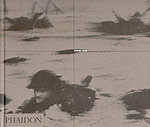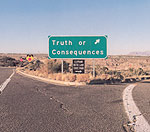Truth or Consequences
| |

| It's always good to have friends recommend books, and I'm grateful to Clare Wadd for pointing me in the direction of Michael Turner's The Pornogropher's Poem. It was Clare's mention of the teacher who delivers her whole curriculum through the study of film and the film-making process that really turned me onto the book, but really that's a small part of a great book that's more about sexual awakening and the insidiousness of mediated notions of 'reality'. I've been thinking myself recently about the possibilities of using the moving image as a mean of teaching various concepts, of helping to make explicit the phases involved in what some of us might call 'creative processes'. I think there's a lot of un-tapped potential there. Of course lens-based media is sometimes delivered in High School but sadly most often it's prohibitively expensive, and the nearest some Art teachers will get to photography is to use the birth of photography as an easy demarcation point in the 'history' of Art: a means of saying 'before/after photography painting was about...' Of course such a broad generalisation is ultimately useless, but it does at least bring into question notions of 'representation' and 'truth' in Art. Of course it wasn't long before Artists started manipulating the photography medium to create illusions, but there has been a long tradition of received perception that says photographs are 'real'. Even in the current climate where everyone and their dog can digitally alter images with remarkable ease, there remains a sense that we believe what we see, in photos and in moving images. I suspect it's getting to the stage of that belief being a crutch, a holding on to what we want to believe of as certainties in a world where there is only fluidity and rapid change. We see what we want to see, believe what we want to believe. Or, if you are maybe a bit more cynical/realist, we see what we are allowed to see, believe what we are told to believe. There's a famous photograph taken during the Spanish Civil War by Robert Capa, of Loyalist Militiaman Federico Borrell Garcia being shot dead in battle just outside of Cordoba on September 5th 1936. It's famous for being hailed as one of the greatest war photographs ever made, and for raising questions about 'reality' and 'truth.' There are arguments over whether the photograph was staged, over whether or not this really is a picture of a solider actually dying in battle. The arguments seem to me to be futile and irrelevant, however. Is this a great photograph? Does it capture the essence of battle and the strange mixture of pointless death and the heroism of fighting for something you care so deeply about you will die for it? And if the answer to those questions is 'yes', then what does it matter if the photo was staged or not? What counts are passions, ideas, beliefs, loves, hates, and the way they relate to people and moments. Truth in itself is as abstract as the universe. Which doesn't mean it's not there, just that it's always in flux. |

| Robert Capa seemed to know this, and the proof is apparent in the recent massive Phaidon collection that shows his photographs were very strongly about people and the movement of stories in and around those people, places and moments in time. It's telling that Heningway based his descriptions in For Whom The Bell Tolls on Capa's photographs of the abortive Loyalist offensive at the Navacerrada pass in May 1937, and there's a great picture of Hemingway and Ilya Ehrenburg in Valencia, Ehrenburg in bed smoking a cigarette and Hemingway stood over him, hands in back pockets of trousers held up by a studded leather belt. Better yet are two portraits of Hemingway from May 1944, with the great writer laid in a London clinic, his head bandaged after a car crash following a party. Of course Capa is rightly famous for his war photography, and for setting up the Magnum agency. In this book there are numerous shots that relate his coverage of the Spanish Civil War, the 1938 Japanese invasion of China and of course WW2. From his 1939 shots of French reservists in cafes through the Allied invasion of Sicily and Italy, through to D-Day and the push through Europe to Berlin, Capa was always at the cutting edge. No more so than when he joined the first wave of landings on Omaha beach in Normandy on June 6th 1944, although it seems cruelly ironic that of the two rolls of film he shot at that time, only eleven frames survived the attentions of an over-eager darkroom worker in London. Of course Capa's photographs of war are provocative and telling, but the more so in the context of this book where they are juxtaposed with images of war's prelude and, more vitally, its aftermath. So as the images of French reservists sitting in a café prior to WW2 reverberate with the retrospective knowledge of what is to come, so the images of refugees fleeing the fighting, or struggling to rebuild lives in the destruction that surrounds them reverberates with the similarly mediated retrospective awareness that such suffering would repeat itself across the decades afterwards; seems likely to continue to repeat itself the world over for decades still to come. Capa's photographs then seem, now as much as ever, to be images that speak to us from the dark pages of history; images that remind us of that the realities of what we may see in the digitally altered and skewed on our televisions or newspaper front pages are inevitably more sad and devastating than we might care to imagine. |

| Truth or Consequences might have been a great title for the Capa collection, and is as great a title for any book of photographs as it is for a town. How could anyone with a camera go wrong recording eight years in a town with such a name? Well, probably very wrong indeed if they didn't have the magic eye of someone like Nick Waplington. Waplington, perhaps most famous for his Living Room series of photographs, has, with his Truth or Consequences collection, turned in both a fascinating record of small-town America and a typically oblique homage to photographic history. Amongst the images that cold no doubt tell a million stories from lonely reflective desert walks to sordid familial disputes and all places in between and far beyond, there are quirky references to photographic histories, some obvious, and some less so. For the photography aficionado it must be a great puzzle book, and even for someone as poorly informed as me, it's a delight. No more so than seeing the image of the ceiling light fixture, so clearly to me a reference to the Bill Eggleston photo that graced the back sleeve of Big Star's Radio City album. It's true that I always assumed that photo was just a 'pop' image of no great consequence other than the fact that it graced a Big Star sleeve, and I'm sure I let out a delighted squeal when I saw an original print of the photo in the New York MOMA a couple of years back. Such are the delights of making the connections, joining the dots. So that looking at Waplington's photo I start to ponder which came first for him; Eggleston or Big Star. I'm banking on Big Star, if only because it seems to me that in this book his photographs often seem to equate with the sound of Big Star songs; shot through with a kind of joyous ravaged honesty and a clear-eyed sadness. Then again, I'm almost certainly wrong, because Eggleston seems to be a favourite of Waplington, there being several echoes of his work in these photographs. Also present in Waplington's Truth or Consequences would be Paul Strand, Winogrand (check out the photo of the tricycle in the driveway), Edward Weston or Stephen Shore, and no doubt there are many more that remain hidden from me, so that in the future, I may come to see some part of a further past and see the connection refracted through time. No doubt then too I shall squeal with delight again. But it would be wrong to suggest that Truth or Consequences is just a book of clever post-modern referencing, because it's inevitably so much more than that. It's much more about people and place and our personal response to them; about both the possibilities and dead-ends presented by and to those people and places by physical and social geography. Truth or Consequences is a provocative, playful and quirkily beautiful book. © Alistair Fitchett 2002 |